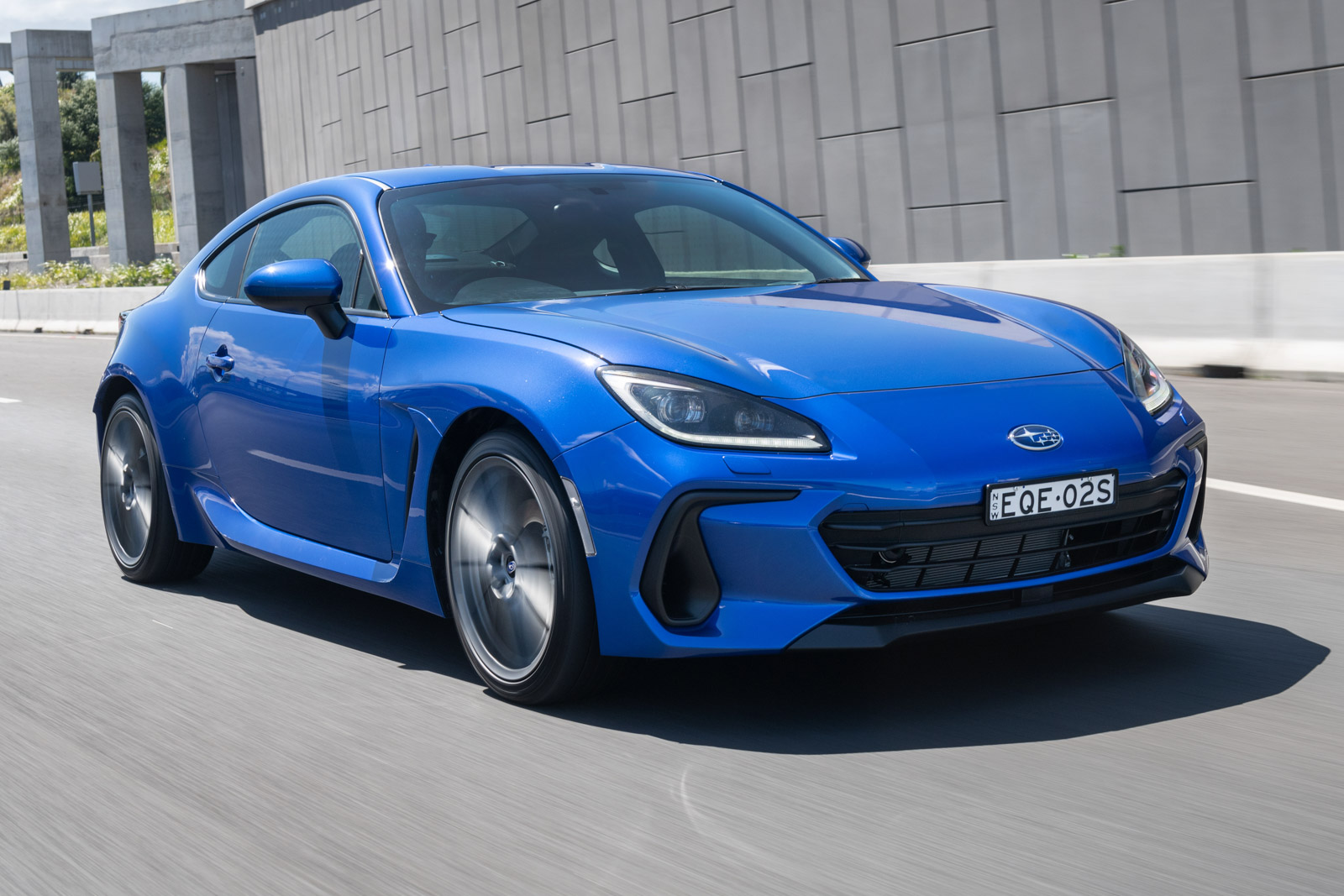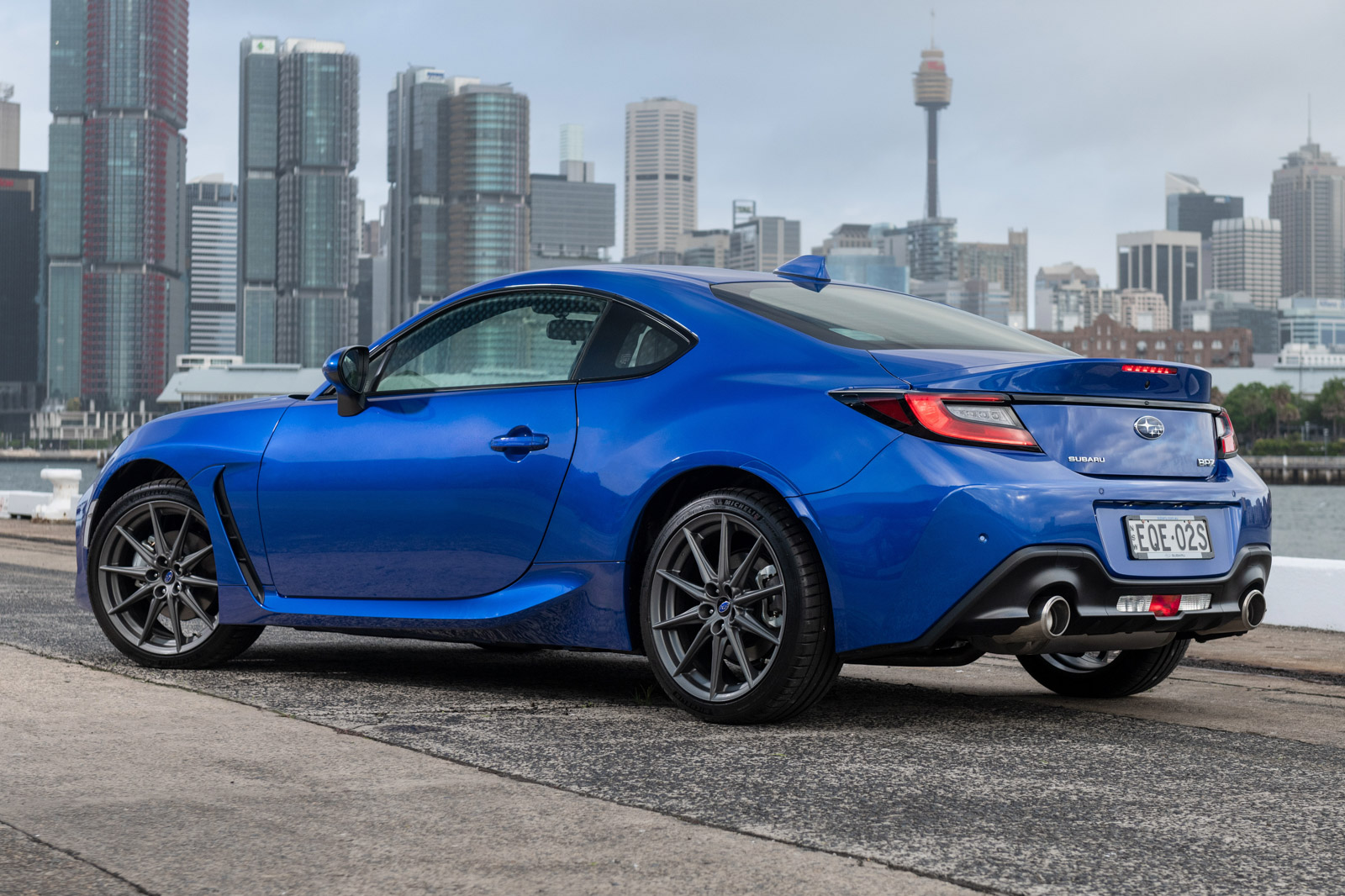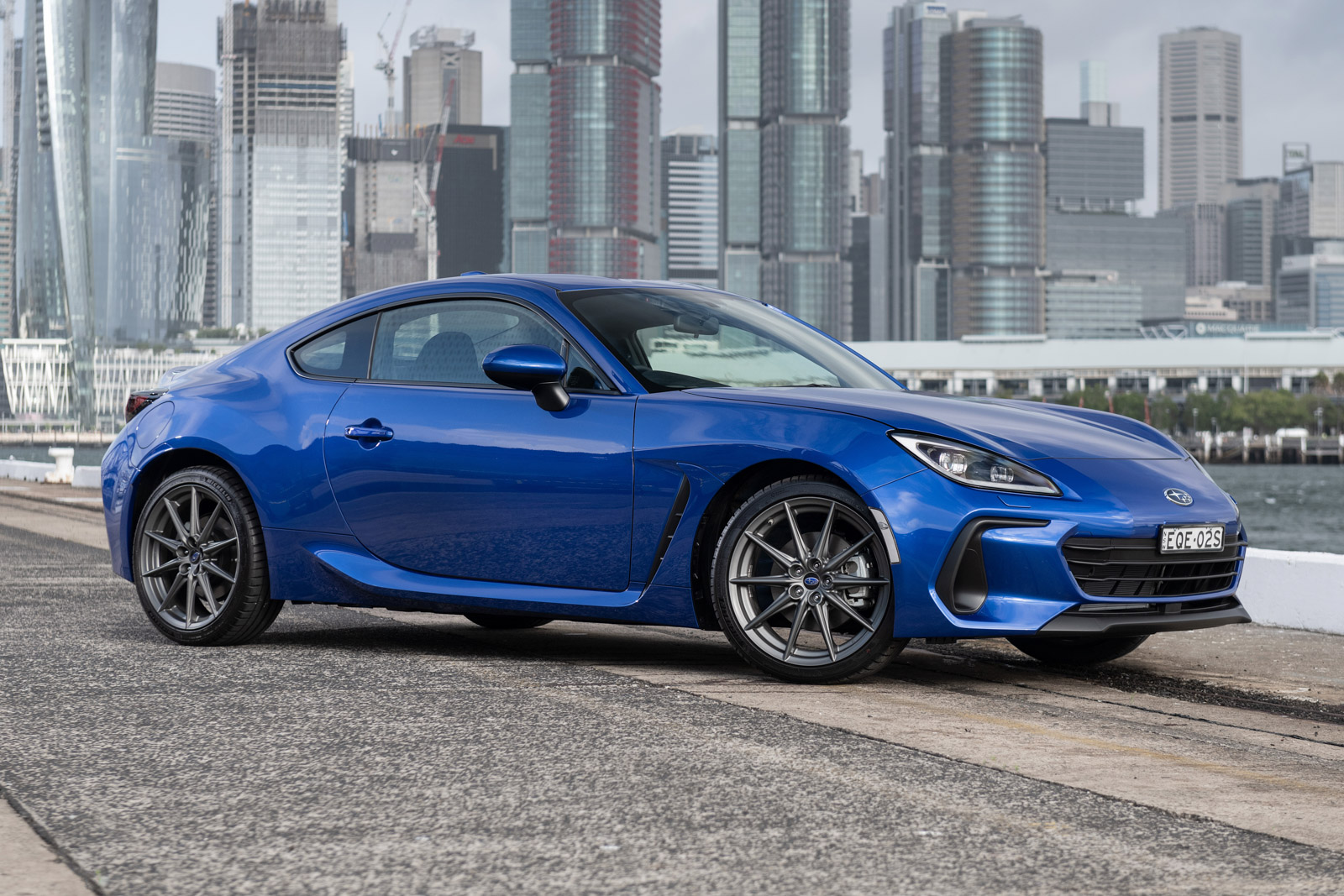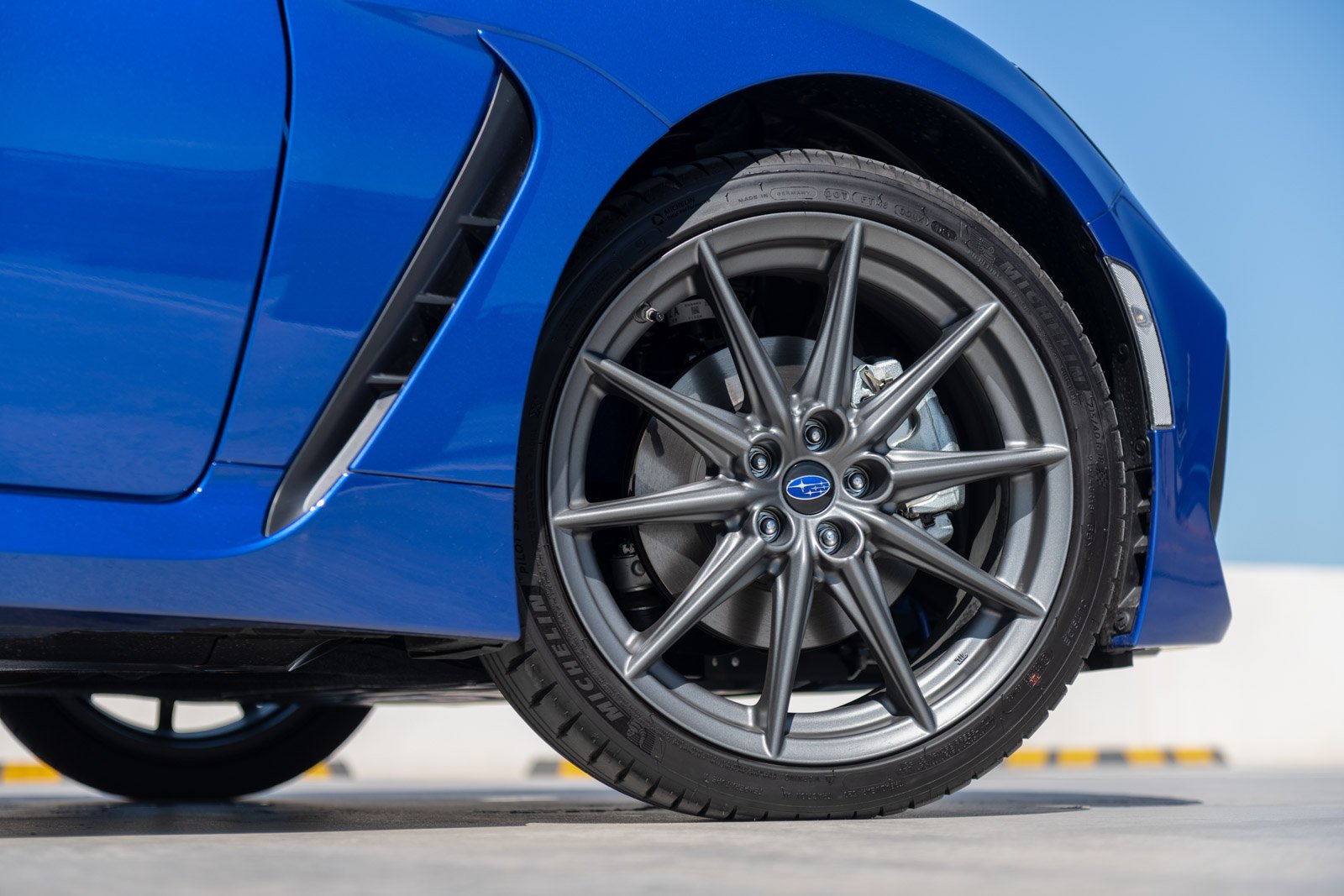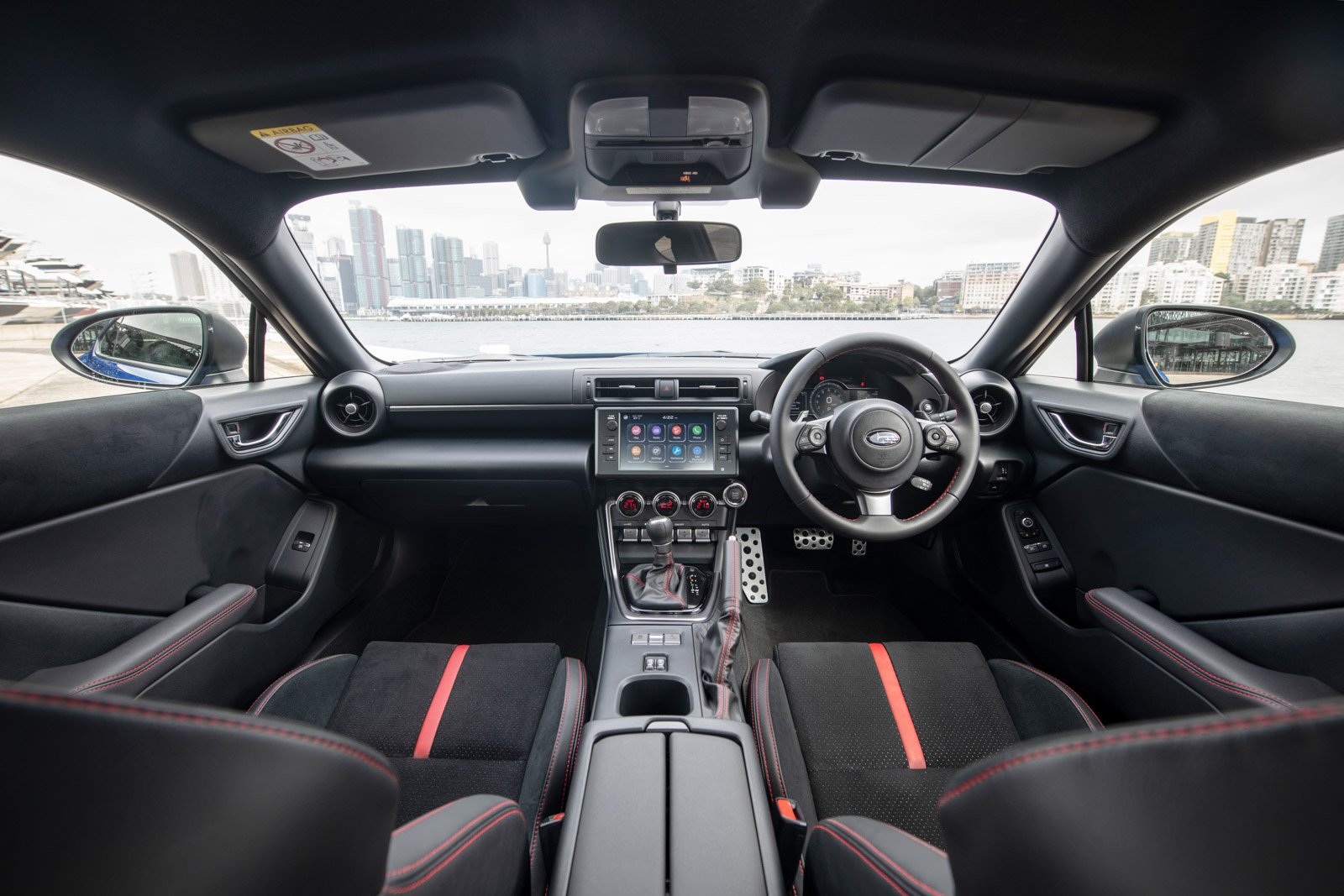We get a taste test of what promises to be one of the most important driver’s cars of 2022.
First, the disclaimer. This is not the definitive test of the second-generation Subaru BRZ. The local launch of the hotly anticipated BRZ redux was based out of Sydney Motorsport Park on a soggy Tuesday and consisted of a fun little motorkhana, a handful of slippery but sedate laps of the 1.8km Amaroo Circuit behind a pace car driven by Molly Taylor (who’d jetted in from the Dakar Rally at midnight the night before) and a 25km guided tour of the 60 and 80km/h zones around the facility.
But all is not lost. Obviously, we can’t wait for longer exposure to the BRZ, especially at higher speeds on more demanding roads, but the Subaru and its Toyota twin have never been complex onion cars. There’s no need to peel back layer upon layer of distraction to find the core car beneath. What you see on the spec sheet is very much what you get.
The second-gen BRZ closely follows the recipe established by the first-gen that arrived to much fanfare back in 2012. The BRZ/86 revived the moribund affordable coupe market, for which enthusiasts were grateful, but the praise wasn’t universal. Not everyone bought into low-grip tyres (which could prove spikey in the wet), many expressed displeasure at the gruff engine’s torque output and delivery, and plenty longed for a turbo.
Well, there’s still no turbo, but the second-gen BRZ should silence the remainder of the criticism, starting with the 2.4-litre naturally aspirated four-cylinder boxer engine. Based on the same capacity engine used in some US-market Subarus, the BRZ’s new engine continues to use the D-4S port- and direct-injection system that featured on the first-gen model. The engine retains the 86mm stroke of the old engine, but the bore is now out to 94mm. Reducing NVH was a key goal for Subaru’s engineers and measures include a redesign of the X-rib bracing within the block and relocating the engine mounts to minimise transfer of vibration to the chassis. The efforts have been a resounding success, with the BRZ’s engine feeling noticeably more refined and mature, even when ask to buzz to 7000rpm where you’ll find the 174kW power peak. Maximum torque is 250Nm and is available at 3700rpm.
Unlike the first-gen BRZ, these figures remain the same whether you opt for the six-speed manual or six-speed automatic. Over the previous-gen auto, the new outputs represent an increase of 27kW and 45Nm, while over the manual the new car is up 22kW and 38Nm. Perhaps more importantly, weight is up just 6-13kg depending on model, which is particularly impressive given the increased equipment levels (more on these shortly).
The weight saving measures include the use of aluminium for the front guards, bonnet and roof skin – the latter saves 2kg and lowers the centre of gravity by 4mm. Even the fuel filler flap was targeted during the BRZ’s diet with the switch from steel to resin resulting in a saving of 470 grams. It’s impressive that a car at this price-point employs such relatively expensive measures to curtail the seemingly inevitable generational bloat. At its lightest (manual BRZ Coupe), the new model weighs just 1246kg, while at its heaviest (BRZ S auto) it’s still a slim 1270kg.
The chassis itself is a remarkable 60 percent stronger in lateral stiffness, while also boasting a 50 percent increase in torsional rigidity. Additional weight savings were found by using aluminium for the wheel hubs (a circa 3kg saving) and employing a hollow front anti-roll bar (400 grams). Both BRZ variants now feature 18×7.5-inch alloys fitted with 215/40 R18 Michelin Pilot Sport 4 tyres – you’ll find a fifth full-sized alloy and Michelin in the boot.
As mentioned, two variants of the BRZ are available and both with six-speed manual or optional six-speed auto. The BRZ Coupe starts the range at $38,990 while the auto can be had for $42,790. The BRZ S manual is $40,190 and the S auto $43,990. Regardless of spec or transmission, all BRZs feature seven airbags, blind spot monitoring, lane change assist and cross traffic alert. Again regardless of spec, automatic BRZs bring Subaru’s EyeSight Driver Assist system that features adaptive cruise, lane departure warning, lane sway warning, lead vehicle start alert, pre-collision braking system, pre-collision brake assist and pre-collision throttle management. Over the BRZ Coupe (again regardless of transmission), the BRZ S adds heated front seats, along with leather and Ultrasuede interior trim.
The green dot on my lanyard sent me first to Sydney Motorsport Park’s skidpan to fling the new BRZ around the sodden expanse of concrete. The new car immediately feels like a favourite pair of running shoes – comfortable and ready for action. You’ve got to be pretty miserable to not enjoy a motorkhana, but the BRZ is hilariously entertaining, slicing through the slalom, sliding around the 90- and 180-degree corners and providing feedback whether you want to goof around or drive with precision.
Next up, the green group was on track for a handful of guided laps around the 1.8km Amaroo circuit. Despite thousands of laps of Sydney Motorsport Park’s Gardner GP circuit, this was my first time on Amaroo. It provides plenty of tight turns and elevation changes to tie a chassis in knots and the slick tarmac was an additional challenge.
While our exposure to the new-generation BRZ was limited, Subaru did provide a pair of first-gen models for back-to-back comparison and this opportunity proved especially illuminating. My first laps came in the new car, tucked up behind an identical BRZ driven by Molly Taylor. Behind me, two colleagues rolled out of pitlane in first-gen BRZs and promptly went backwards out of sight. As you’d expect of a professional driver, Molly drove a neat and economical line, her BRZ changing direction with minimal fuss, though with the occasional tail flick on corner exit.
In my BRZ, the Michelins found impressive purchase on the wet tarmac, sending the engine’s urge to the ground with minimal loss in forward momentum. The front end felt keyed into the surface and only early throttle applications kicked the tail out on exit. I ran in track mode to allow the chassis more freedom before the electronics kicked in and if you kept the inputs smooth, the system allowed many liberties to be taken. While grip levels are low on the wet circuit, body roll was well in check.
Molly and I ran nose to tail for several laps but the two older cars weren’t sighted again. After we pitted, one of their pilots admitted to a very minor excursion after he was caught out by the car’s lack of grip. My turn then.
The train for our second session was Molly, followed by two colleagues in new BRZs and me bringing up the rear in the first-gen model. Up the hill out of pit exit I was immediately dropped as the new car’s torque advantage hit home. The advantage is stretched further as I turned into the first left-right complex and the old car slithered from both ends. Despite being implored not to switch off stability control, I fumbled around on the centre console to kill the electronics that have been extinguishing the fire with every input. For four low-speed laps, my eyes were on stalks and my feet and hands blurred to keep the old car on the tarmac and the train of new cars in sight. It’s a telling display of the advancement that the new car brings.
My final activity of the day was a very short road drive on the industrial and semi-urban roads around SMP. It’s hardly a definitive road test but it’s enough to tell that the firm ride isn’t a deal breaker. I’d recently spent time in a Porsche 911 GT3 and Hyundai i20N and the BRZ is on the softer end of this spectrum. Another quick takeout is that the auto works much better with the larger engine, though I’d still opt for the manual.
So far, the second-generation BRZ has been a sell-out success, with the first 500-unit allocation snapped up prior to launch. Subaru Australia is working with the factory on securing a second allocation and hopes that this will be available towards the end of next quarter. There’s no word yet on how large that allocation will be but demand remains high, especially as Toyota’s GR86 isn’t due in Australia until late in 2022.
Jesse Taylor




